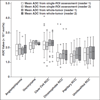Use of DWI in the Differentiation of Renal Cortical Tumors
- PMID: 26700340
- PMCID: PMC4826468
- DOI: 10.2214/AJR.14.13923
Use of DWI in the Differentiation of Renal Cortical Tumors
Abstract
Objective: The purpose of this study was to differentiate clear cell renal cell carcinoma (RCC) from other common renal cortical tumors by use of DWI.
Materials and methods: The study included 117 patients (mean age, 60 years) with 122 histopathologically confirmed renal cortical tumors who underwent 1.5-T MRI that included DWI before they underwent nephrectomy between 2006 and 2013. For each tumor, two radiologists independently evaluated apparent diffusion coefficient (ADC) values on the basis of a single ROI in a nonnecrotic area of the tumor and also by assessment of the whole tumor. The concordance correlation coefficient (CCC) was calculated to assess interreader agreement. The mean ADC values of clear cell RCC and every other tumor subtype were compared using an exact Wilcoxon rank sum test.
Results: Interreader agreement was excellent and higher in whole-tumor assessment (CCC, 0.982) than in single-ROI analysis (CCC, 0.756). For both readers, ADC values for clear cell RCC found on single-ROI assessment (2.19 and 2.08 × 10(-3) mm(2)/s) and whole-tumor assessment (2.30 and 2.32 × 10(-3) mm(2)/s) were statistically significantly higher than those for chromophobe, papillary, or unclassified RCC (p < 0.05) but were similar to those for oncocytoma found on single-ROI assessment (2.14 and 2.32 × 10(-3) mm(2)/s) and whole-tumor assessment (2.38 and 2.24 × 10(-3) mm(2)/s). ADC values were also higher for clear cell RCC than for angiomyolipoma, but the difference was statistically significant only in whole-tumor assessment (p < 0.03).
Conclusion: ADC values were statistically significantly higher for clear cell RCC than for chromophobe, papillary, or unclassified RCC subtypes; however, differentiating clear cell RCC from oncocytoma by use of DWI remains especially challenging, because similar ADC values have been shown for these two tumor types.
Keywords: DWI; MRI; cancer; kidney neoplasms; renal cell carcinoma.
Figures


References
-
- Sun M, Thuret R, Abdollah F, et al. Age-adjusted incidence, mortality, and survival rates of stage-specific renal cell carcinoma in North America: a trend analysis. Eur Urol. 2011;59:135–141. - PubMed
-
- Hollingsworth JM, Miller DC, Daignault S, Hollenbeck BK. Rising incidence of small renal masses: a need to reassess treatment effect. J Natl Cancer Inst. 2006;98:1331–1334. - PubMed
-
- Beck SD, Patel MI, Snyder ME, et al. Effect of papillary and chromophobe cell type on disease-free survival after nephrectomy for renal cell carcinoma. Ann Surg Oncol. 2004;11:71–77. - PubMed
-
- Leibovich BC, Lohse CM, Crispen PL, et al. Histological subtype is an independent predictor of outcome for patients with renal cell carcinoma. J Urol. 2010;183:1309–1315. - PubMed
-
- Lane BR, Babineau DC, Poggio ED, et al. Factors predicting renal functional outcome after partial nephrectomy. J Urol. 2008;180:2363–2368. discussion, 2368–2369. - PubMed
Publication types
MeSH terms
Grants and funding
LinkOut - more resources
Full Text Sources
Other Literature Sources
Medical

